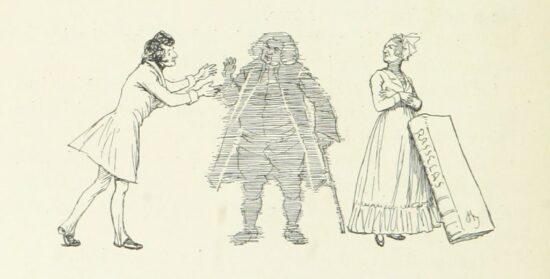Plot and Storyline
“Cranford” is a novel written by Elizabeth Gaskell and first published in 1851. Set in the fictional English town of Cranford during the early 19th century, the story revolves around the lives of the town’s predominantly female inhabitants. The novel is narrated by a young woman, Mary Smith, who frequently visits Cranford and becomes acquainted with its peculiar and endearing residents.
The main story arc of “Cranford” focuses on the challenges faced by the women of the town as they navigate societal norms and expectations. The women of Cranford, who are mostly elderly or unmarried, form a tight-knit community and take pride in their traditions and values. They engage in activities such as afternoon teas, card games, and social visits, which serve as a means of maintaining social bonds and support.
Throughout the novel, various events and encounters occur that both disrupt and reinforce the established order of Cranford. These events include the arrival of new residents, the introduction of modern technologies such as the railway, and the changing economic landscape. The women of Cranford must adapt to these changes while preserving their cherished way of life.
Significant twists and turns in the plot include the illness and subsequent death of a prominent resident, Captain Brown, which brings the community together in grief and highlights the strength of their relationships. Another important event is the inheritance of a large fortune by one of the characters, Miss Matty Jenkyns, which leads to unexpected consequences and tests the loyalty and integrity of those around her.
Overall, “Cranford” offers a glimpse into the lives of a group of women in a small English town, exploring themes of community, friendship, resilience, and the challenges of adapting to a changing world.
Characters
“Cranford” features a rich cast of characters, each with their own distinct personalities and roles within the story. Some of the main characters include:
1. Miss Matty Jenkyns: Miss Matty is one of the central characters in the novel. She is a kind-hearted and traditional woman who struggles to adapt to the changing times. Her inheritance brings both joy and challenges, and her character development showcases her strength and resilience.
2. Miss Deborah Jenkyns: Miss Deborah, the older sister of Miss Matty, is a strong-willed and authoritative figure in Cranford. She embodies the strict adherence to tradition and societal norms. Her character represents the conservative values of the town.
3. Mary Smith: The narrator of the story, Mary Smith is a young woman who frequently visits Cranford. Through her eyes, the reader observes and becomes acquainted with the town’s residents. Mary serves as a bridge between the old and the new, offering an outsider’s perspective on the community.
4. Captain Brown: Captain Brown is a retired military officer who becomes a resident of Cranford. His arrival introduces a degree of disruption to the established social order. He forms a close friendship with Miss Matty and brings a fresh perspective to the town.
These characters, along with many others, interact with each other, forming complex relationships and contributing to the overall themes and conflicts of the novel. Their motivations and actions reflect the struggles of women in a society bound by tradition and the challenges they face in adapting to change.
Themes and Symbols
“Cranford” explores several major themes that resonate throughout the novel:
1. Community and Friendship: The strong sense of community in Cranford is a central theme. The women rely on each other for support, companionship, and shared traditions. Their friendships are essential for navigating the challenges they face.
2. Tradition versus Progress: The clash between tradition and progress is a recurring theme. Cranford represents a world resistant to change, while the introduction of new technologies and social shifts challenge the established order.
3. Gender and Power: The novel examines the limitations and expectations placed on women in the 19th century. The female characters navigate the constraints of their gender while finding strength and autonomy within their community.
4. Resilience and Adaptation: The women of Cranford demonstrate resilience in the face of adversity. They adapt to changing circumstances while maintaining their values and preserving their way of life.
Symbolism is not heavily employed in “Cranford,” but the town itself serves as a symbol of tradition, community, and resistance to change. The rituals and customs of Cranford, such as afternoon teas and card games, symbolize the cohesion and stability of the community.
Writing Style
Elizabeth Gaskell’s writing style in “Cranford” is characterized by its wit, warmth, and keen observation of human nature. Her prose is elegant and descriptive, capturing the nuances of the characters and their interactions. Gaskell employs a third-person omniscient narrator, allowing the reader to gain insights into the thoughts and feelings of multiple characters.
The narrative structure of the novel is episodic, with each chapter presenting a self-contained anecdote or event within the larger framework of thestory. This episodic structure contributes to the overall charm and cozy atmosphere of the novel, as readers are invited to witness the daily lives and interactions of the characters.
Gaskell’s use of language is both engaging and evocative. She employs humor and irony to great effect, often gently satirizing the idiosyncrasies and foibles of the characters. Through her vivid descriptions and dialogue, Gaskell brings the town of Cranford to life, immersing the reader in its quaint charm and distinct social dynamics.
One example of Gaskell’s writing style can be seen in the following passage:
“Miss Matty’s sale was the crowning triumph of the year. The ladies had all been collecting little elegances for months before—French, English, and Swiss trifles, which would have been bargains at twice the money. Miss Matty herself had been to London, and had made the acquaintance of a French lady, who had made her fortune by having an ‘magasin’ de modes, which means a repository of fashions, I believe.”
This passage showcases Gaskell’s ability to create a vivid picture in the reader’s mind while injecting a touch of humor. Her use of the term “crowning triumph” emphasizes the significance of the sale within the town, and the description of the collected items as “French, English, and Swiss trifles” adds an air of sophistication. The mention of Miss Matty’s visit to London and her encounter with a French lady adds an element of intrigue and anticipation.
Gaskell’s writing style enhances the reader’s experience by immersing them in the world of Cranford and creating a strong emotional connection to the characters. Her keen observations of human nature and her ability to capture the complexities of relationships make “Cranford” a compelling and enjoyable read.
Setting and Atmosphere
The setting of “Cranford” plays a significant role in shaping the tone and mood of the novel. The town is depicted as a close-knit community located in the English countryside during the early 19th century. The rural setting, with its picturesque landscapes and slower pace of life, contributes to the idyllic and nostalgic atmosphere of the story.
Cranford’s atmosphere is characterized by its strong sense of tradition, community, and social hierarchy. The town is populated mostly by elderly or unmarried women, who adhere to strict social customs and rituals. The women take pride in their status and find comfort in their shared experiences and traditions. The atmosphere is one of coziness and familiarity, as the women engage in activities like afternoon teas, card games, and sewing circles.
The significance of the time period is also evident in the setting. The early 19th century was a time of significant social and technological change, with the Industrial Revolution transforming England. Cranford, however, remains untouched by these developments, creating a contrast between the traditional and the modern.
Gaskell’s detailed descriptions of the town and its surroundings contribute to the immersive atmosphere of the novel. The reader can almost envision the quaint streets, the cozy cottages, and the beautiful countryside that surround Cranford. The setting enhances the reader’s understanding of the characters and their way of life, creating a rich and vivid backdrop for the story to unfold.
Historical, Social, or Political Context
“Cranford” is set during a time of significant historical and social change in England. The novel reflects the social and cultural context of the early 19th century, particularly in relation to the role of women and the impact of industrialization.
During this period, women’s lives were largely defined by their domestic roles and limited opportunities for independence. The women of Cranford, who are predominantly unmarried, rely on each other for companionship and support. The novel explores the challenges faced by these women in navigating societal expectations and finding fulfillment within the constraints of their gender.
The impact of industrialization is also subtly addressed in “Cranford.” While the town remains insulated from the effects of industrial progress, the introduction of new technologies, such as the railway, serves as a reminder of the changing world outside Cranford. The reluctance of the town’s residents to embrace these changes reflects a broader resistance to the disruptions brought by industrialization.
Gaskell’s portrayal of the social hierarchy within Cranford sheds light on the class divisions prevalent in Victorian society. The women of higher social standing, such as Miss Deborah Jenkyns, hold positions of authority and influence within the community. The novel explores the dynamics of power and the challenges faced by those who do not conform to the traditional social order.
Overall, “Cranford” provides insights into the historical, social, and political context of the early 19th century, highlighting the experiences of women and the impact of societal and industrial changes.
Impact and Reception
“Cranford” has had a lasting impact on literature, particularly in the realm of Victorian literature and the portrayal of female experiences. The novel’s exploration of community, friendship, and the challenges faced by women in a changing world resonates with readers to this day.
Upon its publication, “Cranford” received generally positive reviews from readers and critics. Its charm, wit, and vivid characters captivated audiences, and Elizabeth Gaskell’s skillful storytelling and social commentary were widely appreciated. The novel’s episodic structure, which allowed for a series of interconnected stories, was also seen as a unique and engaging narrative approach.
While “Cranford” did not achieve the same level of immediate acclaim as some of Gaskell’s other works, such as “North and South” or “Wives and Daughters,” it has gained recognition and appreciation over time. The novel’s enduring popularity can be attributed to its portrayal of strong female characters, its examination of social dynamics, and its ability to evoke a sense of nostalgia for a bygone era.
In terms of awards and recognition, “Cranford” did not receive any formal accolades during Elizabeth Gaskell’s lifetime. However, its cultural significance and enduring legacy cannot be underestimated. The novel has been adapted numerous times for television, film, and stage, further cementing its place in popular culture.
The influence of “Cranford” can be seen in subsequent works of literature and media. Its portrayal of female friendships and the strength of community has inspired countless authors who have sought to explore similar themes. Additionally, Gaskell’s nuanced depiction of the challenges faced by women in a traditional society has contributed to the ongoing discourse on gender roles and expectations.
Furthermore, “Cranford” has had a significant impact on the genre of Victorian literature. Its exploration of social change, the clash between tradition and progress, and the dynamics of small-town life paved the way for future works that delved into similar themes.
Final conclusions
In conclusion, “Cranford” by Elizabeth Gaskell has left a lasting imprint on literature. Its portrayal of community, friendship, and the experiences of women in a changing world continues to resonate with readers. The novel’s enduring popularity, adaptations, and cultural significance attest to its place as a classic work of Victorian literature.
Sources:
Cranford by Elizabeth Gaskell | Summary, Quotes, Cranford analysis (victorian-era.org)
Analysis of Elizabeth Gaskell’s Cranford – Literary Theory and Criticism (literariness.org)






